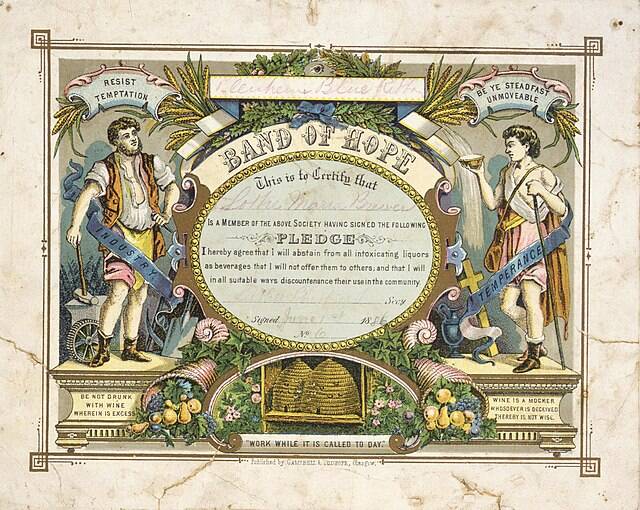Drinking alcohol was considered perfectly usual and acceptable for young children right up until the early 19th century. However, in the Victorian period, the temperance movement, which advocated increasingly for total abstention for all, grew in popularity and power. In 1847, Jabez Tunnicliffe and Ann Jane Carlile founded a children’s temperance organisation entitled the ‘Band of Hope’ in Leeds. The model was widely copied and in 1855 the United Kingdom Band of Hope Union was formed to act as support for local groups. Children as young as seven were encouraged to sign a pledge to abstain from drinking alcohol and even younger children could attend the meetings. (McAllister, 2014).

Entertainments
A key way of publicising the Band of Hope and its message was through public entertainments in which the children took part. There were marching parades and performances at fȇtes. Large concerts, with thousands of participants, took place annually in Crystal Palace or Exeter Hall in London (McAllister, 2014). Local newspapers were full of accounts of more regional productions – describing the events in such vivid detail that we feel as if we were there. The shows were usually in grand halls, decorated with Band of Hope paraphernalia. There were speeches and mini-lectures by local dignitaries. The children sang hymns and ‘temperance melodies’, songs specially composed for the movement. Some programmes included ‘recitations’ and ‘glees’ and at one event in Belfast, there were performances by local bell-ringers. A feature that was associated with the large events and replicated elsewhere was the children using pieces of coloured paper to create ‘kaleidoscopic effects’.
Audience response
The newspaper reports about these local performances were generally warm and appreciative – although reading between the lines, one can see that things did not always go completely smoothly. ‘Perhaps the selection was rather too ambitious’ wrote the The Daily Ipswich Journal. The York Herald claimed that the performance had gone off ‘remarkably well’, considering the age of the performers and the difficulties in getting them together for practice. The audiences, often largely consisting of the children’s parents with a sprinkling of VIPs, were generally reported as being very enthusiastic. This is counted as good night out.
Significance
The Band of Hope were a major force in British life, as is attested by the incredible numbers of children involved: there were around 3.5 million members by 1900 (McAllister, 2014). The ultimate success of the movement is hard to quantify – when they reached adulthood, many former members did choose to drink alcohol, responsibly or otherwise. However, the Band contributed to a cultural shift around alcohol and children and is strongly associated with the association of ‘soft drinks’ as the appropriate beverages for the young on high days and holidays. Its contribution to the cultural life of working class children is perhaps its most lasting legacy, however. In times of patchy schooling, being part of concerts and events such as those described here would have been something to remember and treasure for a lifetime.
References
The Belfast Newsletter (October 27th 1879), ‘Band of Hope Concert in the Ulster Hall’,
The Daily Ipswich Journal (November 19th 1886) ‘Ipswich and Suffolk Band of Hope Union’.
The Ipswich Journal (January 15th 1881) ‘Band of Hope Concert at Needham Market’
McAllister, A. (2014) ‘Giant Alcohol – A Worthy Opponent for the Children of the Band of Hope’, Drugs: Education, Prevention and Policy, vol 22, no 2, pp. 103-110
The York Herald (October 22nd, 1881) ‘Temperance Festival in York’
Picture Credit
Band of Hope Temperance Society, Blenheim Blue Ribbon Branch. Published by Campbell and Tudhope, Glasgow, 1886. Alexander Turnbull Library, Wellington, New Zealand. Wikimedia Commons.
Add comment
Comments